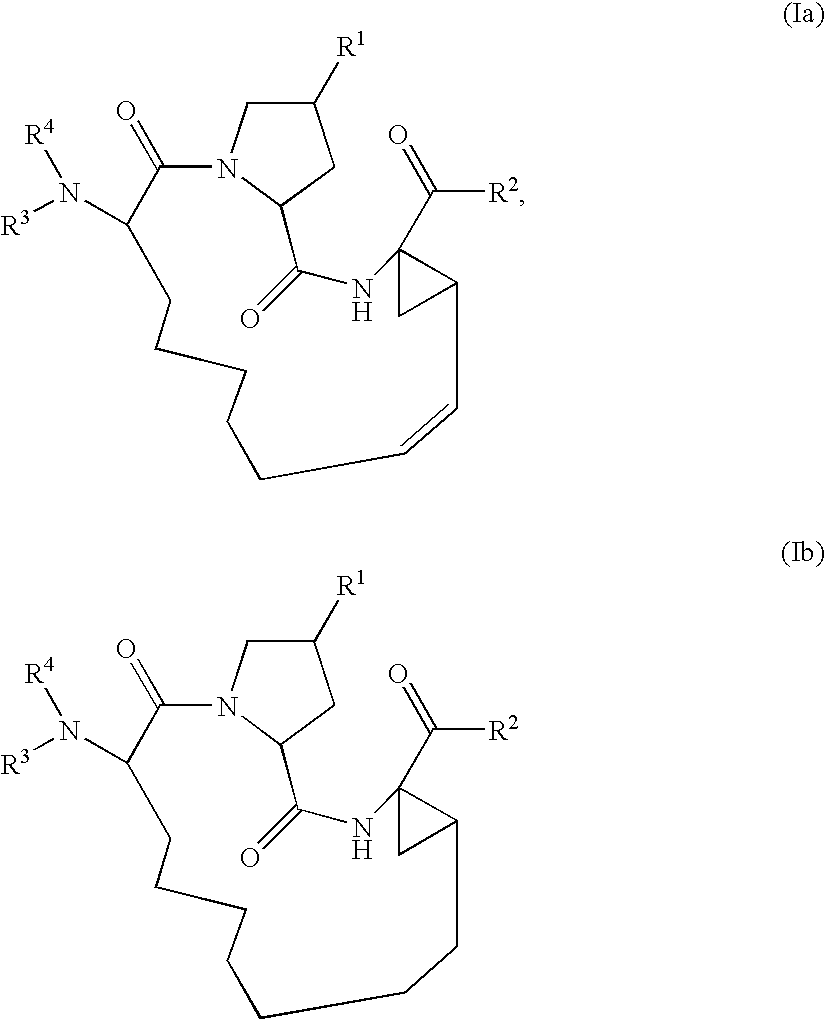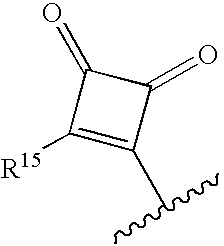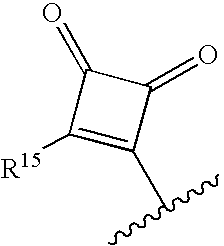Novel Macrocyclic Inhibitors of Hepatitis C Virus Replication
a macrocyclic inhibitor and hepatitis c virus technology, applied in the direction of chemical treatment enzyme inactivation, drug composition, peptide, etc., can solve the problems of 40% to 50% of patients who fail therapy, non-responders or relapsers, patients currently have no effective therapeutic alternative, etc., to achieve the effect of increasing liver function
- Summary
- Abstract
- Description
- Claims
- Application Information
AI Technical Summary
Benefits of technology
Problems solved by technology
Method used
Image
Examples
example 13-1
[1012]
Step 1: Synthesis of tert-butyl 3-(((1R,2S)-1-(ethoxycarbonyl)-2-vinylcyclopropyl)carbamoyl)-6-(3-chlorophenoxy)-3,4-dihydroisoquinoline-2(1H)-carboxylate
[1013]
[1014]To a flask charged with ethyl-(1R,2S)-1-amino-2-vinylcyclopropyl carboxylate (1, 1.0 g, 5.2 mmol), 2-(tert-butoxycarbonyl)-6-(3-chlorophenoxy)-1,2,3,4-tetrahydroisoquinoline-3-carboxylic acid (2.31 g, 1.1 equiv), and HATU (2.7 g, 1.1 equiv) were added 30 mL DMF to make a solution. It was cooled to 0° C. in an ice-water bath, followed by slow addition of a solution of DIEA (4.4 mL, 4 equiv) in DMF (15 mL) while stirring. The reaction was allowed to warm up to rt and stirred overnight.
[1015]After 16 h, the reaction was complete as monitored by HPLC. It was diluted with EtOAc (100 mL), washed with water (3×40 mL), sat. NaHCO3 (2×40 mL), and brine (2×40 mL), then dried over Na2SO4 and concentrated down to give a dark copper colored oil. The crude was purified on the Horizon Biotage instrument using a C-18 column (elue...
example 13-2
[1030]
[1031]Cyclopentyl (1aS,9S,17aR,19aR,Z)-15-(3-chlorophenoxy)-19a-(cyclopropylsulfonylcarbamoyl)-10,18-dioxo-1a,4,5,6,7,8,9,10,12,17,17a,18,19,19a-tetradecahydro-1H-11,14-diaza-bicyclo[13.1.0]hexadeca-1(15),2-dieno[11,12-b]isoquinolin-9-ylcarbamate (Compound 2005) was synthesized according to the procedure described in Example 13-1 and separated as a diasteriomer, (1 mg, 1%) MS m / e 752 (M−−H), using the following preparative HPLC conditions:[1032]Column: YMC ODS-AQ, 20×250 mm, 10-micron particle size, 120-angstrom pore size[1033]Mobile Phase Gradient: 5-95% B in 45 minutes[1034]A: water+0.01% HFBA+1% IPA[1035]B: MeCN+0.01% HFBA+1% IPA[1036]Flow rate: 15 ml / min[1037]Temperature: 25° C.[1038]Wavelength: 220 nm
example 13-3
[1039]
[1040]Cyclopentyl (1aS,9S,17aS,19aR,Z)-15-(3-chlorophenoxy)-19a-(cyclopropylsulfonylcarbamoyl)-10,18-dioxo-1a,4,5,6,7,8,9,10,12,17,17a,18,19,19a-tetradecahydro-1H-11,14-diaza-bicyclo[13.1.0]hexadeca-1(15),2-dieno[11,12-b]isoquinolin-9-ylcarbamate (Compound 2005) was synthesized according to the procedure described in Example 13-1 and separated as a diasteriomer, (5 mg, 4%) MS m / e 752 (M−H), using the following preparative HPLC conditions:[1041]Column: YMC ODS-AQ, 20×250 mm, 10-micron particle size, 120-angstrom pore size[1042]Mobile Phase Gradient: 5-95% B in 45 minutes[1043]A: Water+0.01% HFBA+1% IPA[1044]B: MeCN+0.01% HFBA+1% IPA[1045]Flow rate: 15 ml / min[1046]Temperature: 25° C.[1047]Wavelength: 220 nm
PUM
 Login to View More
Login to View More Abstract
Description
Claims
Application Information
 Login to View More
Login to View More - R&D
- Intellectual Property
- Life Sciences
- Materials
- Tech Scout
- Unparalleled Data Quality
- Higher Quality Content
- 60% Fewer Hallucinations
Browse by: Latest US Patents, China's latest patents, Technical Efficacy Thesaurus, Application Domain, Technology Topic, Popular Technical Reports.
© 2025 PatSnap. All rights reserved.Legal|Privacy policy|Modern Slavery Act Transparency Statement|Sitemap|About US| Contact US: help@patsnap.com



